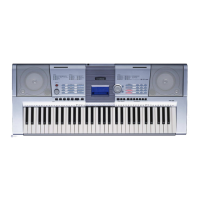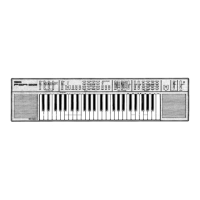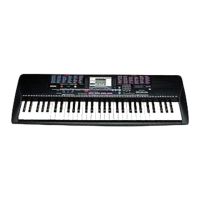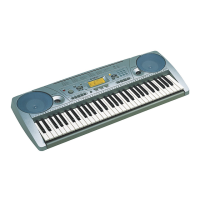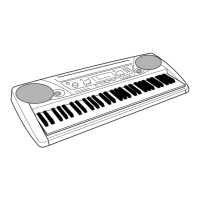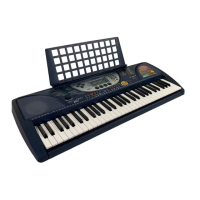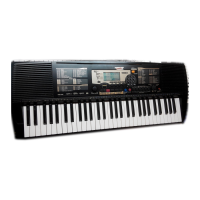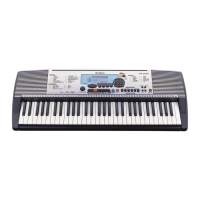Why does my Yamaha Electronic Keyboard sound change from note to note?
- TTodd MendozaSep 10, 2025
This is normal. The AWM tone generation method uses multiple recordings (samples) of an instrument across the range of the keyboard.

Why does my Yamaha Electronic Keyboard sound change from note to note?
This is normal. The AWM tone generation method uses multiple recordings (samples) of an instrument across the range of the keyboard.
| Type | Portable Keyboard |
|---|---|
| Model | PSR-293 |
| Number of Keys | 61 |
| Touch Response | Yes |
| Polyphony | 32 |
| Display | LCD |
| Speakers | 12cm x 2 |
| Effects | Reverb, Chorus |
| Connectivity | MIDI In/Out |
| Amplifiers | 2.5 W × 2 |
| Power Supply | AC Adapter or Batteries |
Yamaha reserves the right to change or modify specifications without prior notice.
Owner's responsibility for service charges incurred due to lack of knowledge.
Yamaha's commitment to producing user-safe and environmentally friendly products.
Information regarding small non-rechargeable batteries and their replacement.
Modifications not approved by Yamaha may void FCC authority.
Use only high-quality shielded cables and follow all installation instructions.
Product complies with FCC Part 15 for Class "B" digital devices.
Follow basic precautions to avoid injury, shock, damage, fire, or other hazards.
Follow basic precautions to avoid physical injury or damage to the instrument.
Avoid dust, vibrations, extreme temperatures, and direct sunlight for instrument care.
Procedures for connecting to other electronic components and managing volume levels.
Use a soft, dry cloth for cleaning; avoid solvents and cleaning fluids.
Instructions for safe handling, avoiding foreign objects, and proper operation.
Save desired panel settings and data to internal Flash Memory before powering off.
Standard for playing GM-compatible music data on tone generators.
Simplified version of Yamaha's XG tone generation format.
Universal Serial Bus interface for connecting computers and peripheral devices.
CD-ROM includes USB driver and Musicsoft Downloader software for data transfer.
Play along with songs, sounding like a pro even with wrong notes.
Change the keyboard sound to various instruments like violin, flute, or harp.
Features songs for listening or playing along, with lessons and performance evaluation.
Use auto-accompaniment styles for full backing band accompaniment.
Instructions for using AC power adaptor or batteries for instrument operation.
Connect headphones or external audio devices to the PHONES/OUTPUT jack.
Connect an optional footswitch for natural sustain effect while playing.
Connect to a computer via USB for data transfer and software use.
Procedure for turning the instrument on and off using the STANDBY/ON switch.
Diagram and labels for the front panel controls of the DGX-205/203 model.
Diagram and labels for the front panel controls of the PSR-295/293 model.
Diagram showing rear panel connections like USB, SUSTAIN, PHONES/OUTPUT, DC IN 12V.
Detailed list and page references for all front panel buttons and controls.
Detailed list and page references for all rear panel connection terminals.
Learn to play piano with the instrument's performance assistant technology.
Use the performance assistant technology by playing songs with chord data.
Explains how the technology creates music from random notes using chord data.
Adjust the tempo of songs for practice or performance using the TEMPO/TAP button.
Listen to the instrument's demo songs to experience its voices.
Procedure to select and play the main voice on the keyboard.
Select a second voice to play in addition to the main voice using the DUAL function.
Play different voices to the left and right of a "split point" using the SPLIT function.
Instantly select the Grand Piano voice with a single button press.
Use the pitch bend wheel to add smooth pitch variations to notes.
Control note volume by how hard keys are played, similar to a real piano.
Use drum kits to play individual drum and percussion sounds via keyboard keys.
Play a range of sound effects, like submarine or bell, using specific voices.
Learn how to use the auto-accompaniment feature with various styles.
Explains how the left-hand section becomes the accompaniment range.
How to initiate style playback using the accompaniment range and sync start.
Play melody with the right hand while playing chords with the left hand.
Add harmony notes to your melody based on played chords.
Immediate, Chord, and Synchro Start methods for initiating style playback.
Start style playback by tapping the TEMPO/TAP button at the desired tempo.
Immediate Stop, Synchro Start Mode, and Ending playback methods to stop styles.
How to select and play back the instrument's built-in songs.
Identifies three types of songs: Preset, User, and External song files.
Organizes the 30 preset songs into 8 categories for easier lesson selection.
Learn correct notes; the song waits for the correct note input.
Selects Lesson 1 mode, enabling the instrument to wait for correct note input.
Feature to repeat difficult sections or practice sections after mistakes.
Learn correct timing; tempo adjusts to player's speed, increasing gradually.
Play along with the song minus the part you have chosen to practice.
Select different styles to arrange existing songs, creating new musical arrangements.
Listen to how songs sound with different styles and select a suitable one.
Select a melody voice for the song or change the keyboard voice.
Details the 6 tracks (5 melody, 1 style) that can be recorded individually.
Explains how to specify tracks for recording melody, chords, and style parts.
Step-by-step guide on how to select user song numbers and record tracks.
How recording begins and the current measure display during recording.
Methods to stop recording, including using endings or recording other tracks.
Instructions for playing back recorded user songs and re-recording tracks.
Procedure to delete an entire user song, including all its tracks.
How to delete a specific track from a user song.
Save instrument parameters like user songs and settings to flash memory.
Restore factory defaults by clearing backup data or flash memory.
Simple operations: press button, use dial, start function.
Adjust the sound volume using the MASTER VOLUME control.
Indicates buttons that can be pressed and held for longer than a second for related functions.
How to use the dial and number buttons to select items or change values.
Procedure for starting playback of songs or styles using the START/STOP button.
Explains various indicators and information shown on the LCD display.
Features that enhance musical performance, like Reverb, Chorus, and Metronome.
Apply concert hall ambience to the sound by selecting different reverb types.
Create a thicker sound similar to unison playing by adding chorus effects.
Built-in metronome for setting time signatures and tempos for practice.
Adjust keyboard sensitivity to dynamics in three steps for expressive playing.
Automatically selects a well-balanced voice for a selected style or song.
Individually adjust parameters like volume, octave, pan, reverb, and chorus for voices.
Adjust the harmony volume level for specific harmony types.
Adds sustain to keyboard voices at all times, regardless of footswitch operation.
Change the key that separates the split voice and main voice sections.
Turn auto-accompaniment off to play only the rhythm parts of a style.
Play chords in the accompaniment range while the style is stopped to hear accompaniment chords.
Set the style volume level between 000 and 127.
Explains Easy Chords and Standard Chords methods for playing accompaniment.
Use the chord dictionary to learn how to play specific chords.
Adjust the volume level for selected songs.
Specify a section of a song for repeat playback.
Mute individual tracks (melody, percussion, accompaniment) within a song.
Transpose the pitch of songs up or down by semitones or cents.
Use transport controls to navigate playback of songs.
Change the melody voice of a song to any other preferred voice.
Save preferred panel settings (voice, style, etc.) to Registration Memory for quick recall.
Load previously saved panel settings from Registration Memory to the instrument.
Access and adjust detailed instrument settings via the FUNCTION button.
Comprehensive list of all available Function settings and their ranges.
Details settings for PC Mode, MIDI, Metronome, Lesson, and Utility functions.
Explains Musical Instrument Digital Interface and its role in transmitting data.
Connect the instrument to a computer using a USB cable for MIDI data transfer.
Important safety and operational precautions when connecting via USB.
Configure instrument settings for MIDI data transmission and reception.
Settings to optimize MIDI communication between the instrument and computer.
Use the instrument's panel to control computer applications like Digital Music Notebook.
Step-by-step guide for transferring songs from the CD-ROM to the instrument.
How to set guide tracks (right/left-hand parts) for using transferred songs in lessons.
Copyrights, usage agreements, and warnings about playing the CD-ROM on an audio player.
Lists the applications and data included on the CD-ROM.
Instructions for checking system requirements and connecting the instrument.
Lists the OS, CPU, Memory, Hard Disk, and Display requirements for software.
Procedures for uninstalling software and installing the USB-MIDI Driver.
Step-by-step guide for installing the USB-MIDI driver on Windows 98/Me.
Step-by-step guide for installing the USB-MIDI driver on Windows 2000.
Step-by-step guide for installing the USB-MIDI driver on Windows XP.
Instructions for installing essential software applications from the CD-ROM.
Covers grant of license, restrictions, copyright, liability, termination, and miscellaneous clauses.
Addresses common instrument issues like no sound, popping sounds, and display problems.
Solutions for software issues like driver installation failure or delayed playback.
Steps to delete or reinstall the USB-MIDI driver on Windows systems.
Details on keyboards, display, setup options, panel controls, and realtime controls.
Specifications for instrument voices, styles, and fingering methods.
Specifications for educational features, memory, functions, effects, MIDI, metronome, lessons, and utility.
The instrument supports a maximum of 32 simultaneous notes.
A comprehensive list of all panel voices with their numbers and MIDI data.
Lists voices organized by categories like PIANO, ORGAN, GUITAR, etc.
Lists more voice categories including SYNTH LEAD, SYNTH PAD, DRUM KITS, and XGlite voices.
Lists remaining voice categories such as BRASS, FLUTE, PIPE, and BASS.
Provides detailed information on drum kits, including notes and assignments for each drum sound.
Lists all 135 auto-accompaniment styles categorized by genre.
A list of the 30 built-in songs, including their file names and categories.
Lists the MIDI songs available on the accessory CD-ROM for transfer.
Details the 26 harmony types, their effects, and usage conditions.
Lists the available reverb types, from Hall 1-3 to Plate 1-2, and Off.
Lists the available chorus types, including Chorus 1-2 and Flanger 1-2.
Maps MIDI values to effect types for Reverb and Chorus, showing values and corresponding displays.
Covers grant of license, restrictions, copyright, liability, termination, and miscellaneous clauses.
Outlines consumer duties for warranty service, including contact and proof of purchase.
Lists conditions under which the warranty does not apply, such as neglect or unauthorized repair.
